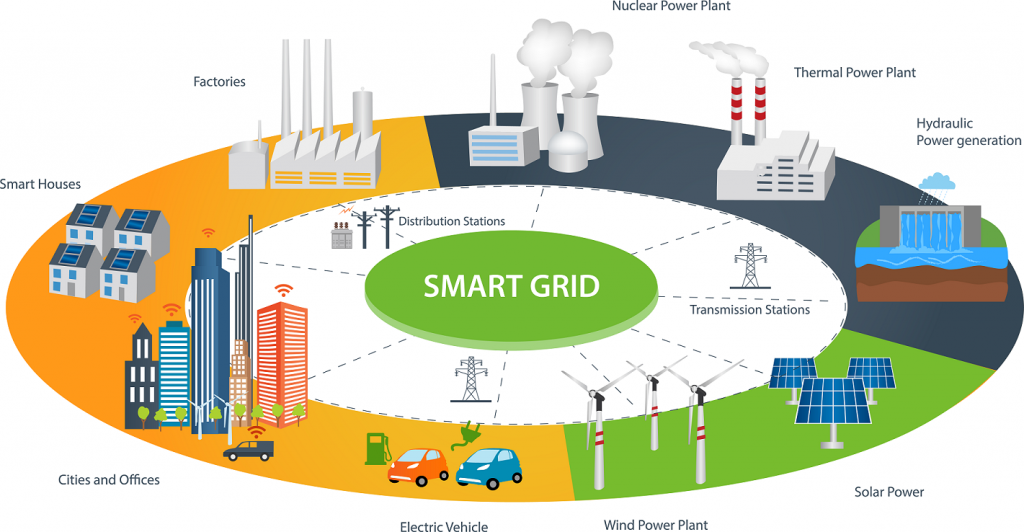Five Minute Facts About Packet Timing
By Andreja Jarc.
Evolution of Grids
The power grid has been operating for a long time, long before data networks and ethernet systems were popular. It is one of the world’s largest infrastructures and also one of the most robust one. Therefore, one might ask, why are we not distributing power the way was done in the past.
The answer is hidden in how the power is used nowadays and this requires modern power grids to be more complicated than they used to be.
First of all, the loads have been changing. They used to be resistive. For example, wire filament light bulbs used to be the biggest load on a power grid and those behave as resistors in an electric circuit.
These days, however, the power loads are more capacitive as everyone is charging their favorite electronics, like: phones, tablets, laptops or electric cars. Even lights have become more capacitive as they don’t use filament bulbs any more, but rather newer technologies such as LEDs instead.
As the load has become more reactive, current and voltage are not in phase with each other anymore and this makes the grid a little less stable.
A Smart Grid Concept

Another thing which has changed power grids significantly is the use of number of different clean energy sources that are usually intermittent– sources like solar and wind, where generators are making power some of the time but not all the time. The power generation of renewable sources is highly dependent on weather.
Grid operators are often required to buy the excess of energy from homes and businesses that have solar or wind generators. Sometimes these sites are generating an excess of energy and operators are required by regulations to accept it. Sometimes is the other way around when they don’t generate enough, therefore operators have to supply the energy to the site.
Considering these examples, we can see that the power has become a much more complicated interface to an end-user as it was in the past.
Needs for Sync in Power Grids
So what has all this now to do with precise timing in power grids after all?
First of all, time is used in various ways in the power grids with quite a variety of accuracy requirements.
For example IT data used in a control room in a power station. Here they need a sort of standard log file coordination between enterprise, IT, servers and routers. All these network appliances have their log files where they want to put time tags on, with accuracy probably within a second.
On the other hand we have a SCADA system defined by IEC, which has a very specific time requirement within 1 ms. SCADA is used mainly for grid wide monitoring and control.
The biggest timing improvement in grids has been achieved by using synchrophasors. They are used for monitoring grid stability and predict faults by measuring the phase change in power lines. The timing standard for synchrophasors is 1 micro second.
Synchrophasors mostly monitor voltage phase over time at a lot of different substations. They are looking down the line to see how the phase is changing. If the phase changes rapidly with time or if it starts changing rapidly with position more than they would expect, that would be a sign of some kind of instability in the grid. The IEEE C37.118.1 standard recommends keeping the Total Vector Error below 1%.
In one of our partner projects we were measuring the phase difference in low frequency power lines of Swedish railways. By measuring phasors we were able to adjust the frequency and fine-tune the operation in order to reduce power losses. For more information about this use case, please follow this link.
Another important utilization of precise timing has been used lately with traveling wave fault detection, where fault detectors are scattered throughout the grid. They can identify voltage spikes that are characteristic if a line is going down or if a transformer is in troubles. And by triangulating from the detectors in time they could estimate where a fault has occurred. This could save time for maintenance team, to tell drivers where they should go to repair a system. The less time they spend driving and looking around where the fault is, the more efficient they become. There is no standard for that. The more precise it is the more accurate you can locate the position. It is roughly 1 meter of position error for every 3 ns of timing error.
Here are some other devices in substations that need precise timing:
- Intelligent Electronic Devices (IEDs)
- Phase measurements units (PMUs)
- Merging Units – these are the things that take in analogue measurements and digitize it
- Protective Relays
Sometimes these are merged into devices, where devices have multiple functions.
| Functionality | Need for Timing | Accuracy required | Timing Technology |
| Control Room | Log file coordination | 1 sec | (S)NTP |
| SCADA System | Grid wide monitoring and control | 1ms | NTP, IRIG |
| Syncrophasors | Monitoring of grid stability. Faults predictions. | 1us | IRIG IEEE C37.118.1-2011 IEEE1588 PTPv2 |
| Traveling wave fault detection | Locations of faults to within 100 m. Improves maintenance efficiency. | 300ns | IEE1588 PTPv2 |
Table 1: Sync requirements in Power Grids.
I would like to acknowledge my colleague Dr. Doug Arnold for his valuable technical insights in the topic.
If you have more questions about timing in power grids, don’t hesitate to send me an email at andreja.jarc@meinberg.de or visit our website at www.meinbergglobal.com. Wish you all a nice summer!
If you enjoyed this post, or have any questions left, feel free to leave a comment or question below.